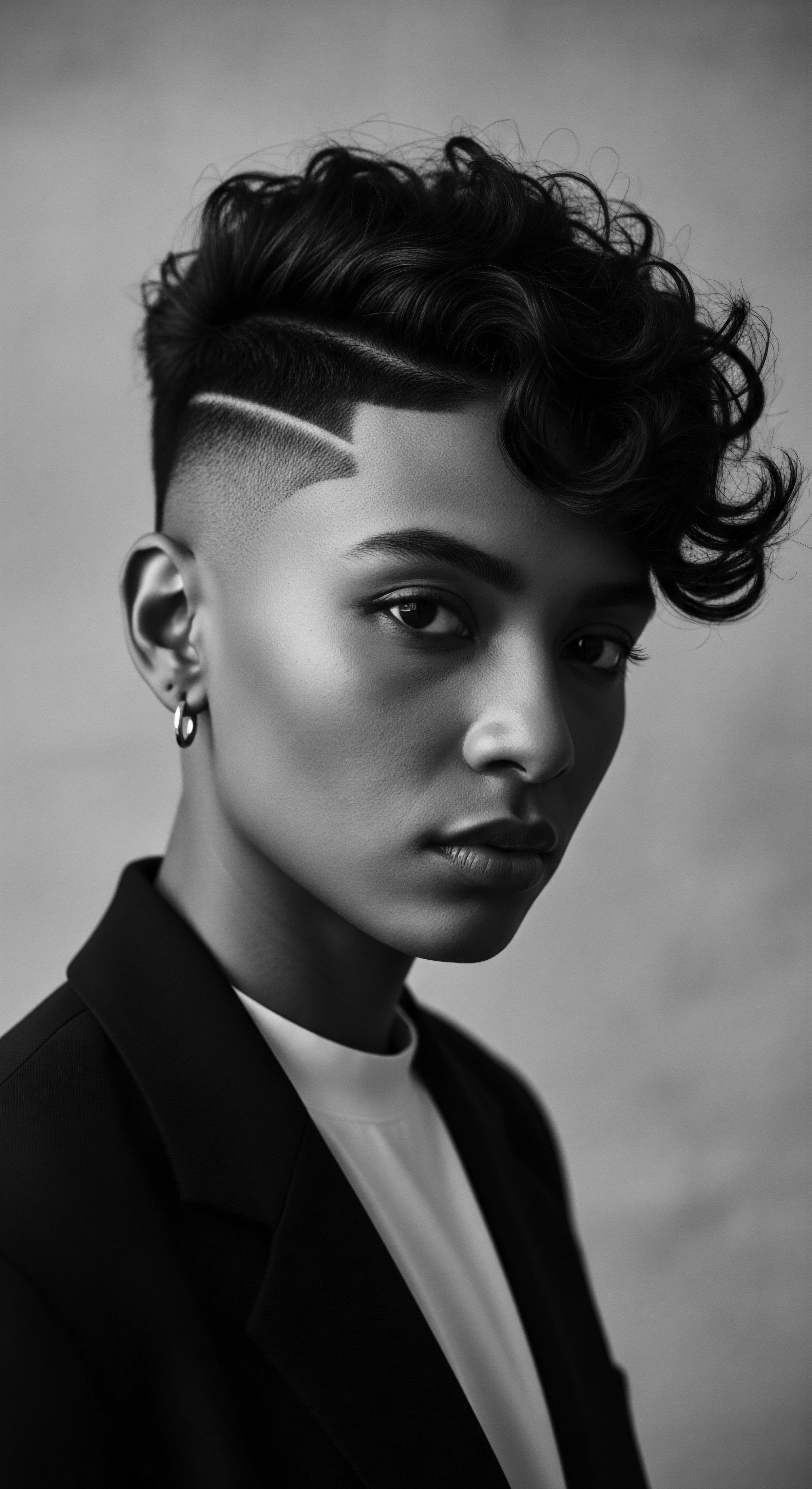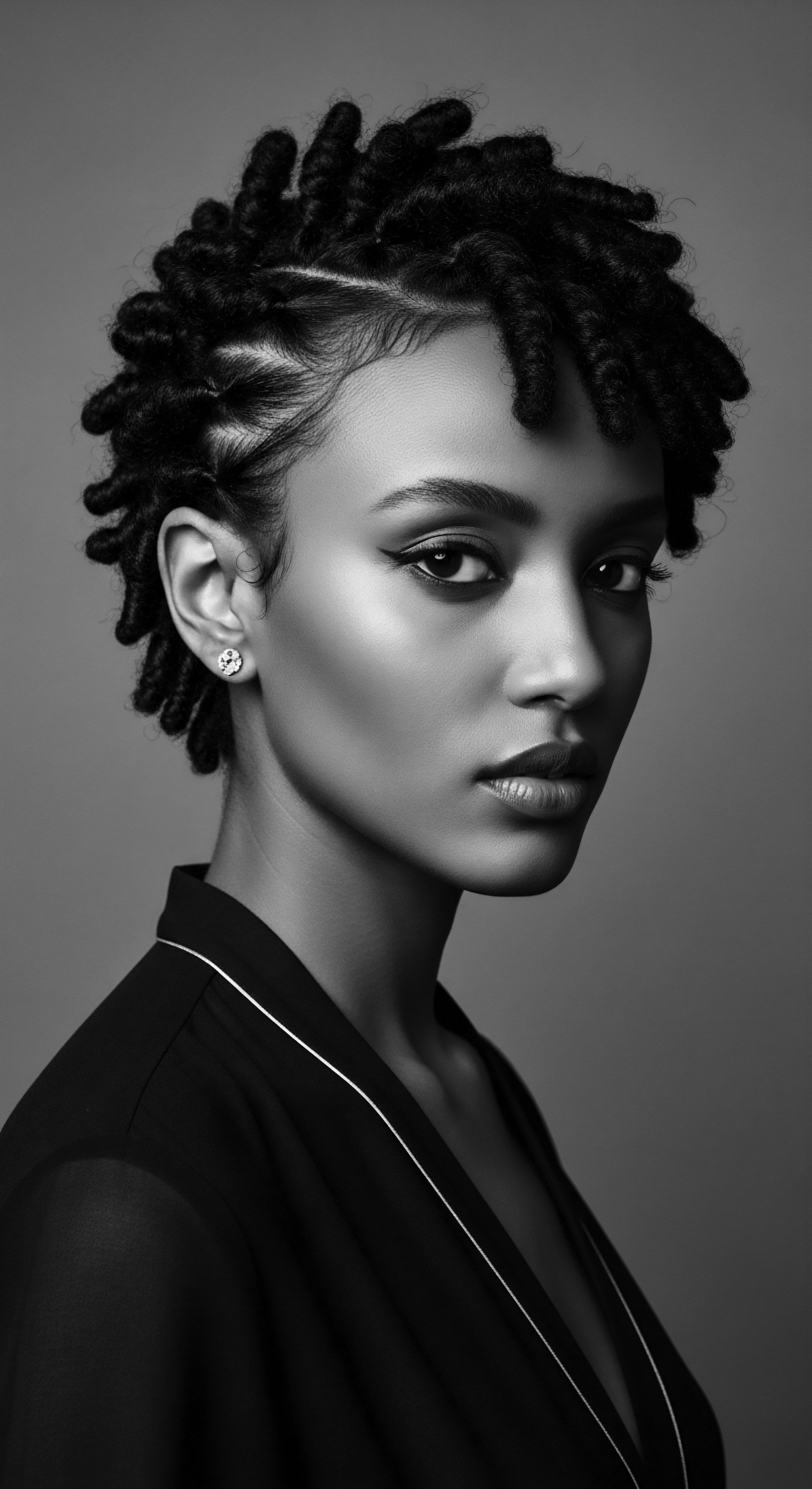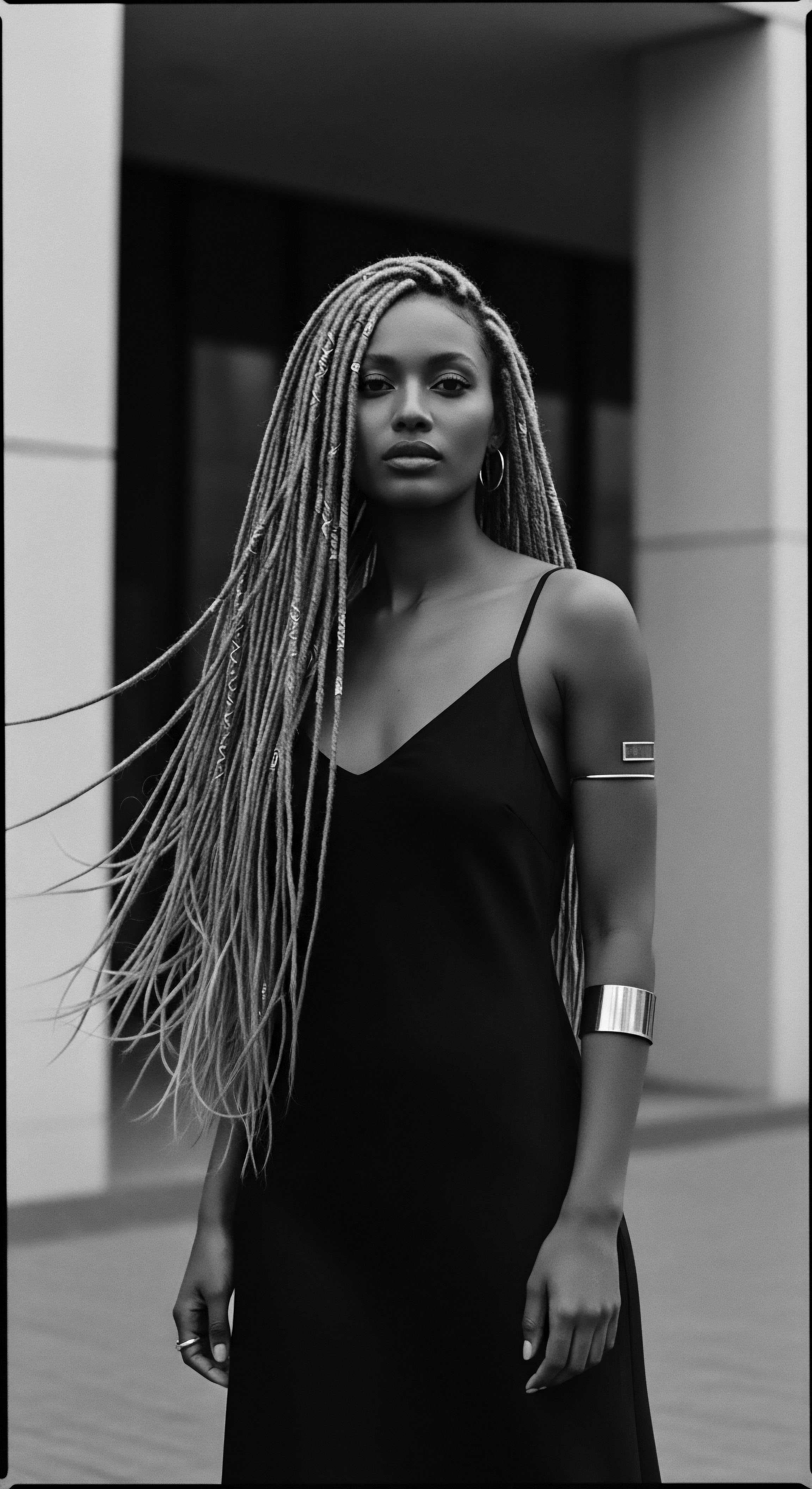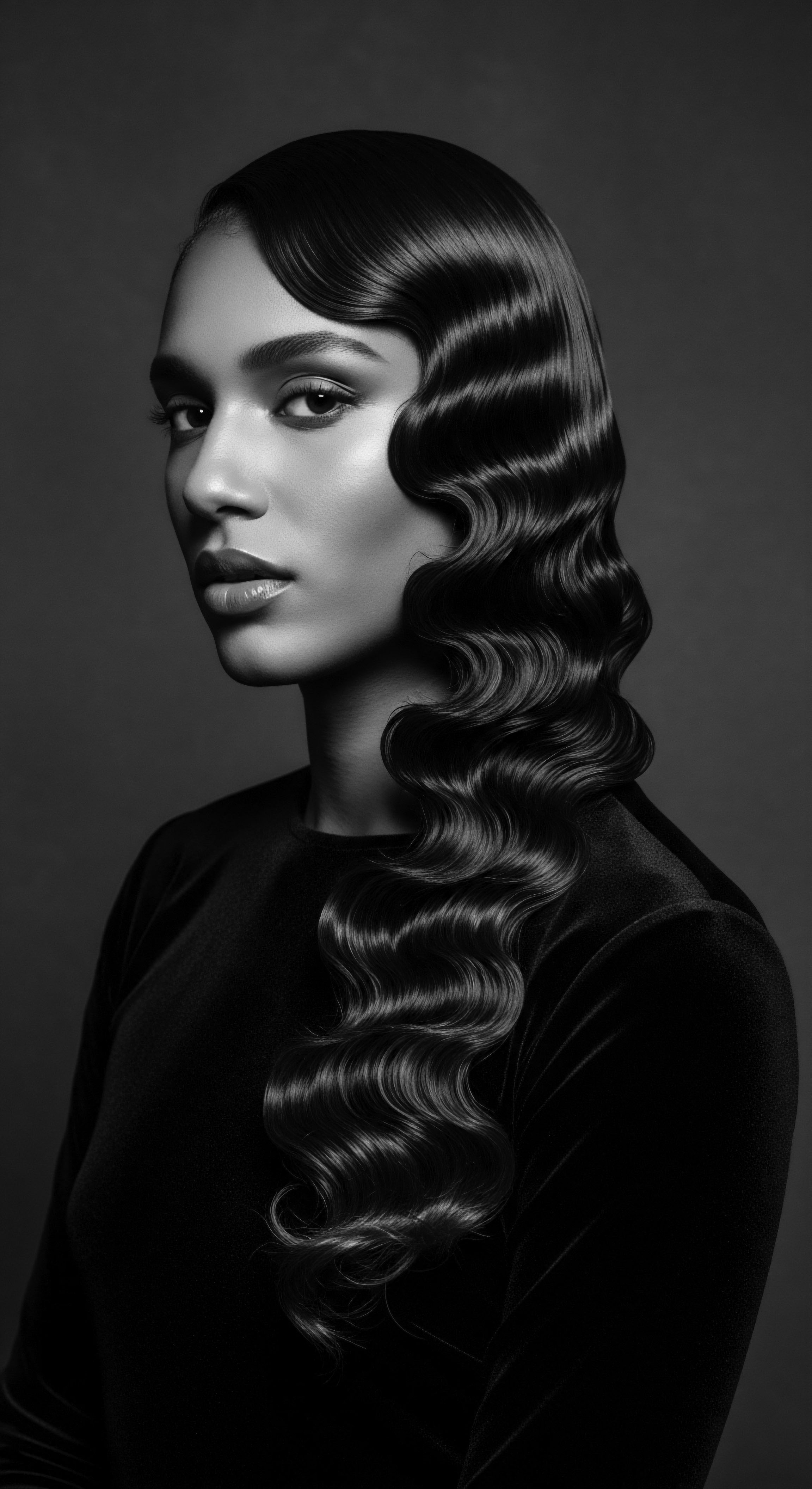
Roots
To truly understand if traditional nighttime hair care can truly protect textured hair long term, one must first listen to the whispers of antiquity, where the very act of preserving hair was entwined with survival, identity, and profound ancestral knowledge. For those whose lineage flows through the rich soils of Africa and across the diaspora, hair has never been a mere adornment. It stands as a living archive, a sacred filament connecting generations, a testament to resilience woven into every coil and curl. The question of nighttime care, then, becomes a meditation on how deep wisdom, passed down through the ages, aligns with the intricate biology of textured strands to offer enduring preservation.
Our journey begins at the source, in the fundamental understanding of textured hair, not as a deviation from a norm, but as a masterpiece of biological adaptation. Imagine the West African sun, relentless and vibrant. Hair, in its natural state, served as a protective crown, its unique structure a shield against the elements, a natural insulator retaining vital moisture. This understanding, that hair is inherently delicate and therefore requires deliberate safeguarding, is a core tenet of ancestral care.
The tight curl patterns, the ellipticity of the hair shaft, and the lower density of cuticle layers, render textured hair more susceptible to moisture loss and breakage compared to straighter hair types. This biological reality made conscious, continuous care not a luxury, but a vital practice.
Ancestral wisdom regarding textured hair care is deeply rooted in biological understanding and environmental adaptation.

The Strand’s Ancient Blueprint
The very anatomy of textured hair, distinct in its helical twists and turns, necessitates a different approach to preservation. Unlike straight hair where sebum, the scalp’s natural oil, can easily travel down the shaft, the intricate curves of coiled hair present barriers. This means moisture often struggles to reach the ends, leaving them prone to dryness and brittleness.
Early communities, perhaps without the lexicon of modern dermatology, instinctively understood this. Their solutions were pragmatic and remarkably effective ❉ rich, natural emollients applied directly to the hair and scalp, and methods to contain and protect the hair from physical abrasion and environmental exposure.
Consider the shea tree (Vitellaria paradoxa), indigenous to West Africa. Its butter, a creamy, nourishing substance, was—and remains—a cornerstone of hair and skin care across many African cultures. Its occlusive properties create a barrier, locking in moisture and protecting the delicate hair shaft from the harsh sun and dry winds.
This was not a scientific discovery in a laboratory, but an observation gleaned from generations of living intimately with the land and its offerings. The use of such ingredients speaks to an intuitive, ecological intelligence, where resources were honored for their inherent properties and applied with thoughtful intention.

Cultural Nomenclature of Care
The language surrounding textured hair care in various African communities and throughout the diaspora also tells a story of heritage. Terms and practices, often unwritten but universally understood within their contexts, reflect a deep respect for hair. They convey a nuanced understanding of its needs long before modern science articulated the specifics of keratin bonds or cuticle integrity.
- Kiko ❉ Among the Yoruba people of Nigeria, this term often refers to the threading technique, an ancient protective style. It is a testament to hair preservation.
- Duku ❉ A term for headwraps in Ghana and Namibia, signifying not only protection but also identity and status.
- Doek ❉ Used in South Africa for head coverings, serving similar purposes of protection and cultural expression.
These terms are not merely labels; they carry the weight of generations of shared wisdom, of mothers teaching daughters, of community gatherings where hair care was a collective ritual. The knowledge embedded within this lexicon underscores the historical truth ❉ nighttime hair protection, even in its most rudimentary forms, was an indispensable part of long-term hair health and cultural continuity.
| Ancient Practice Application of Shea Butter |
| Traditional Purpose Moisture retention, sun protection, hair strengthening |
| Modern Scientific Alignment Occlusive properties prevent water loss; rich in vitamins A and E for hair shaft integrity. |
| Ancient Practice Hair Threading (e.g. Irun Kiko) |
| Traditional Purpose Hair stretching, length retention, protection from breakage |
| Modern Scientific Alignment Minimizes manipulation and exposure to environmental stressors, reducing friction. |
| Ancient Practice Wearing Headwraps / Bonnets |
| Traditional Purpose Protection from elements, maintenance of styles, signifying status |
| Modern Scientific Alignment Reduces friction against rough surfaces, maintains moisture, protects from dust and environmental damage. |
| Ancient Practice These ancestral methods reveal a profound, intuitive understanding of textured hair's needs, predating modern scientific explanation. |
The wisdom of early communities did not view hair care as separate from general wellbeing. It was, rather, an integral part of a holistic existence, where one’s appearance reflected one’s inner state and connection to community. The practices established in those primordial times—the careful application of nourishing oils, the wrapping of hair for slumber or journey—were not just for beauty, but for safeguarding the very essence of the strand against the inevitable wear of daily existence. This foundational understanding sets the stage for appreciating the long-term protective power of traditional nighttime care.

Ritual
The rhythms of life, from the rising sun to its gentle descent, have long dictated the cadence of textured hair care. Within this framework, nighttime rituals transcend mere habit; they become a sacred pause, a deliberate act of protection and renewal. For centuries, across continents and cultures, the practice of preparing hair for sleep has been a quiet but powerful testament to the enduring understanding of textured hair’s unique needs. This is where the art of traditional styling converges with the science of preservation, creating a tender thread that binds present practices to an ancient lineage.
The ancestral impulse to protect hair while sleeping was a response to the inherent fragility of textured strands. As observed in the British Association of Dermatologists’ recommendations, afro-textured hair is notably prone to dryness, breakage, and tangles due to its tight curl pattern hindering sebum distribution. Sleeping on rough surfaces, such as cotton pillowcases, exacerbates this vulnerability by creating friction, leading to frizz, breakage, and moisture loss. Traditional practices, long before the advent of modern textiles, intuitively addressed this by wrapping hair in softer materials or by styling it in ways that minimized stress.

The Sacred Act of Wrapping
The hair bonnet, a seemingly simple accessory, possesses a profound heritage . Its origins are deeply tied to African communities, where head coverings served diverse purposes ❉ protecting hair from the elements, preserving intricate hairstyles, and even signifying social status or tribal affiliation. This practice traveled across the transatlantic slave trade, transforming into a symbol of resilience and identity for African American women.
During enslavement, bonnets and headwraps were instrumental in protecting hair from harsh conditions. Post-slavery, this tradition endured, evolving into a crucial tool for hair preservation, allowing women to maintain styles for longer periods and minimize damage.
The strategic use of headwraps, often made from natural fibers, evolved into the satin and silk bonnets we recognize today. The smooth surface of these materials allows hair to glide, preventing the friction that cotton creates. This reduces mechanical stress on the hair shaft, mitigating breakage and split ends.
Moreover, these coverings help to seal in moisture, which is especially critical for textured hair prone to dryness. This historical adaptation, from practicality born of necessity to a conscious choice for hair health, illustrates the deep connection between ancestral wisdom and enduring hair protection.
Nighttime hair rituals, often centered on protective coverings, are echoes of ancestral resilience and intelligent adaptation to hair’s natural vulnerabilities.

Traditional Styling for Nighttime Sanctuary
Beyond simply covering the hair, traditional nighttime care often involved specific styling techniques designed to maintain hair integrity. These methods served multiple purposes ❉ preventing tangles, preserving curl patterns, and stretching the hair to reduce daily manipulation.
The practice of braiding hair, particularly cornrows, dates back to 3500 BC in Africa. These intricate styles were not just aesthetic; they were functional, protecting delicate afro-textured hair from daily wear and tear. At night, looser braids or twists were often formed to keep the hair contained and prevent knots. This practice, often referred to as “finger detangling” or “twisting,” allows for gentle separation of strands, minimizing breakage when preparing for rest.
Consider the Bantu knots , a style deeply rooted in Southern African heritage. These small, coiled buns not only create definition when unraveled, but also serve as a protective style for sleeping. They keep the hair tucked away, preventing friction and maintaining moisture. Such practices reveal a nuanced understanding of hair manipulation, where even the act of preparing for bed was a thoughtful step in a long-term care regimen.
- Twists ❉ A fundamental technique, often done in sections, to stretch hair and prevent tangles overnight.
- Braids ❉ Loose, larger braids or cornrows protect hair from friction and help retain moisture.
- Pineappling ❉ A method where hair is gathered loosely at the crown to preserve curls and reduce flattening.
The evolution of these styling rituals speaks to the adaptive genius of communities striving to maintain hair health amidst varied challenges. From the deliberate weaving of cornrows that could serve as maps to freedom during enslavement, to the simple act of wrapping hair in a silk scarf, each practice carries the indelible mark of cultural legacy and a profound wisdom about safeguarding textured hair.

Relay
The echoes of ancient nighttime rituals reverberate through contemporary textured hair care, forming a powerful relay of knowledge across generations. The question of whether traditional nighttime hair care truly protects textured hair long term finds its most compelling affirmation here, in the convergence of ancestral wisdom with modern scientific understanding. This final pillar delves into the holistic influence of these practices, demonstrating their enduring relevance and their capacity to shape the future of textured hair health.
The protective measures undertaken before sleep are more than superficial acts; they are integral components of a robust, long-term regimen. Consider the core vulnerability of textured hair ❉ its natural propensity for dryness and fragility. The British Association of Dermatologists suggests regular moisturizing between wash days, using lotions, creams, or oils, and covering hair at bedtime with a satin or silk cap or scarf. This modern recommendation mirrors centuries-old practices of applying natural emollients and employing protective coverings.
The scientific explanation for this alignment is clear ❉ satin and silk fabrics significantly reduce friction, which prevents mechanical damage to the delicate cuticle layer of textured hair. This minimization of friction is vital for preventing breakage, retaining length, and maintaining the hair’s inherent moisture.

The Bonnet’s Unbound Legacy
The humble bonnet, a symbol of self-care and cultural connection, carries within its threads the resilience and ingenuity of Black women through history. It was worn not only for overnight hair care but also as an expression of resistance and pride in times of discrimination. In the 1960s and 1970s, during the Black Power movement, the bonnet experienced a revival as part of the natural hair movement , becoming an ally for those celebrating their authentic hair textures. This historical journey underscores a vital truth ❉ long-term protection is not solely about physical preservation but also about psychological wellbeing and cultural affirmation.
Can traditional nighttime hair care truly protect textured hair long term, especially when considering the sheer volume of daily hair interactions? The answer is a resounding yes, bolstered by consistent practice. The act of wrapping hair, be it in a silk scarf or a bonnet, significantly reduces tangles and knots that might otherwise form during sleep.
This, in turn, lessens the need for aggressive detangling in the morning, a common cause of breakage for textured hair. The collective impact of these small, consistent nightly acts accumulates over time, resulting in healthier, longer strands.
The consistent practice of traditional nighttime hair protection fosters physical hair health and strengthens cultural identity.

Holistic Care for Generational Radiance
Ancestral wisdom viewed hair care as part of a larger continuum of holistic wellness, a perspective gaining renewed appreciation today. The ingredients traditionally used for nighttime treatments speak to this interconnectedness. Ingredients like castor oil , used in ancient Egypt, were prized for their moisturizing and strengthening properties.
In India, Ayurvedic practices emphasize scalp massages with warm oils, like coconut oil, believed to stimulate hair growth. While these practices might not have been strictly ‘nighttime’ rituals, their application of nourishing oils and scalp treatments informed general hair health, contributing to a foundation that could be protected nightly.
The effectiveness of traditional nighttime hair care in providing long-term protection is powerfully illuminated by the enduring heritage of length retention in certain African communities. The Bassara/Baggara Arab tribe women of Chad are renowned for their remarkably long, strong hair, attributed to their consistent use of Chébé powder . This powder, made from the seeds of the Chébé plant, is mixed with water and moisturizing substances like shea butter and applied to the hair, which is then braided to lock in hydration.
This process, while not strictly a ‘nighttime-only’ ritual, is performed regularly and then the hair is protected, often with braids, which naturally extends into sleep. The emphasis here is on consistent, long-term application of nourishing ingredients followed by protective styling, illustrating how integral care, including nighttime care, contributes to impressive length retention.

Why Does Consistent Nighttime Protection Matter for Hair’s Future?
The long-term benefits of traditional nighttime care are multifaceted. They stem from a continuous reduction of stressors that chip away at hair health over time. Without these practices, textured hair faces:
- Increased Friction Damage ❉ Leading to cuticle lifting, frizz, and breakage.
- Excessive Moisture Loss ❉ Resulting in dry, brittle strands highly susceptible to damage.
- Frequent Manipulation ❉ Requiring more detangling and styling daily, which adds stress.
By consistently applying protective measures, textured hair is shielded from these daily aggressors. The benefits compound, contributing to sustained length retention, improved hair health, and a vibrant appearance over years. This is the unbound helix of heritage and science, spiraling forward, ensuring that the wisdom of the past continues to protect and adorn textured hair for generations to come.

Reflection
To ponder the journey of textured hair is to walk through a living, breathing archive—a testament to ingenuity, resilience, and an unbroken lineage of self-care. The inquiry into whether traditional nighttime hair care can truly protect textured hair long term reveals a truth far deeper than scientific data or historical dates. It speaks to a soulful understanding that hair is a part of us, an extension of our heritage , deserving of thoughtful, consistent protection.
The gentle wrapping of coils, the application of ancestral emollients, the deliberate choice of a bonnet or scarf—these are not merely acts of maintenance. They are continuations of a legacy, whispers of wisdom passed through touch and tradition, ensuring that the vibrancy of the strand remains undimmed by the passage of time or the friction of daily life.
In these practices, we see the enduring ‘Soul of a Strand’—a recognition that each filament carries not just its biological makeup, but the stories, struggles, and triumphs of those who came before. Nighttime care, therefore, becomes a quiet communion, a reaffirmation of identity, and a commitment to nurturing what has been cherished for generations. It is a powerful reminder that while the world around us may shift and technologies advance, the fundamental wisdom of caring for our textured crowns remains a profound and protective act, ensuring their radiance for all tomorrows.

References
- Byrdie. (2022, September 27). The Significance and History of Bonnets. Crowned.
- DaluNaht. (2025, May 26). The tradition of the bonnet – more than just a hair accessory.
- Hype Hair. (2023, June 26). Unveiling the History of the Hair Bonnet for Black Women.
- Obscure Histories. (2024, February 13). Ancient Gems ❉ A Historical Survey of African Beauty Techniques.
- Refinery29. (2021, February 23). The Evolution Of The Natural Hair Movement.
- Regirl. (2020, July 31). 7 Simple Ways to Protect Your Natural Hair While Sleeping.
- Semin Cutan Med Surg. (2009). Hair Care Practices in African-American Patients.
- The History and Evolution of Hair Bonnets ❉ From Traditional to Modern Styles. (2024, July 1).
- The History of Textured Hair. (2020, August 28). Colleen.
- VertexAISearch. (2025, April 18). She Tried an Ancient African Hair Mask—Here’s What Happened Overnight!
- VertexAISearch. (2025, March 4). Historical Perspectives on Hair Care and Common Styling Practices in Black Women. MDEdge.
- VertexAISearch. (2025, February 18). The History and Symbolism of Hair Wrapping Across the African Diaspora.
- YouTube. (2022, November 11). Historical Hair Care Grew My Hair to Hip Length! Here’s How.
- YouTube. (2018, February 11). A Brief History on Head Wraps | BLACK GOLD | Black History Month Series.
- British Association of Dermatologists. Caring for Afro-textured hair.
